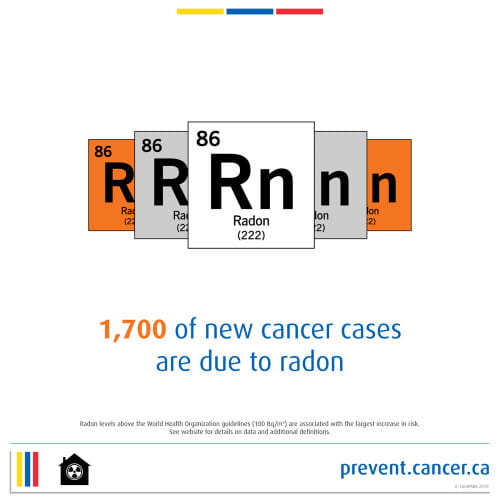It has no colour, no odour and no taste. It can attach to dust and other substances in the air we breathe.
We may not be able to see, smell, or taste radon, but it’s critical to be able to detect it. Understanding what radon is – and how we’re exposed to it – can protect our health and make a life-changing difference for Canadians each year. Released this year, the Canadian Population Attributable Risk of Cancer (ComPARe) study found that about 1,700 of new lung cancer cases are due to radon.
Are you familiar with radon and how it can affect your health? Learn more about where this gas is most commonly found and why it can be dangerous:
1. Radon is a radioactive gas found naturally in the environment. It’s released into the air during the natural breakdown of uranium in rocks and soil. From there, it breaks down into radioactive elements that can attach to dust and other substances in the air.
2. Exposure to radon gas increases your risk of lung cancer. Radon is one of the leading causes of lung cancer in non-smokers – and smokers are at an even higher risk of developing lung cancer if they are exposed to radon.

3. Outdoor air contains some radon, but it poses more of a risk indoors. Outdoor radon levels are generally very low, since the radon gas is constantly diluted by fresh air. Because of this, released radon is quickly dispersed and radon gas doesn’t build up to levels high enough to pose a health risk. When radon enters buildings through foundations, joints and vents, it can accumulate to higher, unsafe concentrations. Indoor air can have high levels of radon (more than 200 Bcq/m3) when radon from the soil and rocks around a building seeps into cracks and crevices and builds up in enclosed spaces. This is particularly true in basements, which can be more poorly ventilated than other areas of the home.
4. But if you work underground, you may be at high risk of radon exposure. We’re exposed to radon when we breathe contaminated air. If you work in a mine (uranium or any other type that is underground), you may breathe air that has naturally high levels of radon if proper ventilation systems are not in place. If you work in underground, make sure you know how to protect yourself at work.
5. You can test your home for radon. The age of your home or radon levels in other houses and buildings in your neighborhood will not indicate how high radon levels will be in your home. To test for radon, you can buy a relatively inexpensive test kit at your local hardware store or hire a professional to test your home for you. It’s important that you work to reduce radon to as low as possible. If the level of radon is above 200 Bcq/m3, you should work with a C-NRPP certified professional to lower the levels in your home.
At the Canadian Cancer Society, we’re here to help educate Canadians about cancer-causing substances and potential exposure to them. By understanding where radon can be found and how it can be harmful, people across Canada can continue to make informed decisions that protect the health of themselves and their families.
